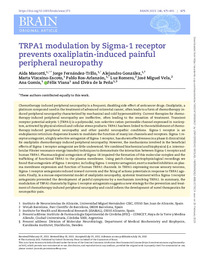Título :
TRPA1 modulation by Sigma-1 receptor prevents oxaliplatin-induced painful peripheral neuropathy |
Autor :
Marcotti, Aida
Fernández Trillo, Jorge
González, Alejandro
Vizcaíno Escoto, Marta
Ros Arlanzón, Pablo
Romero, Luz
Vela, José Miguel
Gomis García, Ana María
Viana de la Iglesia, Félix
De La Peña García, Elvira María |
Editor :
Oxford University Press [University Publisher] |
Departamento:
Departamentos de la UMH::Fisiología
Instituto de Neurociencias |
Fecha de publicación:
2023-02-13 |
URI :
https://hdl.handle.net/11000/30712 |
Resumen :
Chemotherapy-induced peripheral neuropathy is a frequent, disabling side effect of anticancer drugs. Oxaliplatin, a platinum compound used in the treatment of advanced colorectal cancer, often leads to a form of chemotherapy-induced peripheral neuropathy characterized by mechanical and cold hypersensitivity. Current therapies for chemotherapy-induced peripheral neuropathy are ineffective, often leading to the cessation of treatment. Transient receptor potential ankyrin 1 (TRPA1) is a polymodal, non-selective cation-permeable channel expressed in nociceptors, activated by physical stimuli and cellular stress products. TRPA1 has been linked to the establishment of chemotherapy-induced peripheral neuropathy and other painful neuropathic conditions. Sigma-1 receptor is an endoplasmic reticulum chaperone known to modulate the function of many ion channels and receptors. Sigma-1 receptor antagonist, a highly selective antagonist of Sigma-1 receptor, has shown effectiveness in a phase II clinical trial for oxaliplatin chemotherapy-induced peripheral neuropathy. However, the mechanisms involved in the beneficial effects of Sigma-1 receptor antagonist are little understood. We combined biochemical and biophysical (i.e. intermolecular Förster resonance energy transfer) techniques to demonstrate the interaction between Sigma-1 receptor and human TRPA1. Pharmacological antagonism of Sigma-1R impaired the formation of this molecular complex and the trafficking of functional TRPA1 to the plasma membrane. Using patch-clamp electrophysiological recordings we found that antagonists of Sigma-1 receptor, including Sigma-1 receptor antagonist, exert a marked inhibition on plasma
membrane expression and function of human TRPA1 channels. In TRPA1-expressing mouse sensory neurons,
Sigma-1 receptor antagonists reduced inward currents and the firing of actions potentials in response to TRPA1 agonists.
Finally, in a mouse experimental model of oxaliplatin neuropathy, systemic treatment with a Sigma-1 receptor
antagonists prevented the development of painful symptoms by a mechanism involving TRPA1. In summary, the modulation of TRPA1 channels by Sigma-1 receptor antagonists suggests a new strategy for the prevention and treatment of chemotherapy-induced peripheral neuropathy and could inform the development of novel therapeutics for neuropathic pain.
|
Palabras clave/Materias:
cold allodynia
neuropathic pain
TRPA1
Sigma-1 receptor
chemotherapy |
Tipo documento :
application/pdf |
Derechos de acceso:
info:eu-repo/semantics/openAccess |
DOI :
https://doi.org/10.1093/brain/awac273 |
Aparece en las colecciones:
Artículos Fisiología
|
 La licencia se describe como: Atribución-NonComercial-NoDerivada 4.0 Internacional.
La licencia se describe como: Atribución-NonComercial-NoDerivada 4.0 Internacional.
.png)
